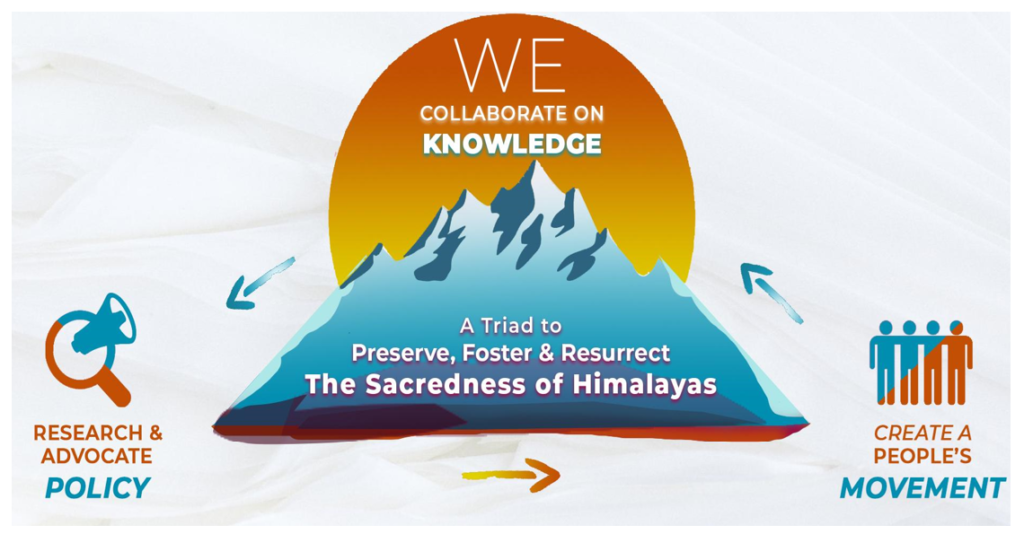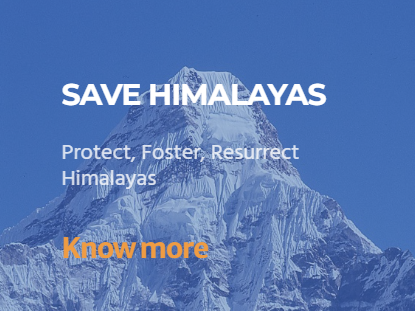



Himalay Unnati Mission (HUM)
What is HUM?
Himalaya Unnati Mission (HUM) is a movement to Preserve, Protect & Resurrect the biological, economic, cultural, and spiritual heritage of the Himalayas. The initiative blends policy level research for state and central government, with grassroots developmental projects in the Himalayan Region by working with Government, Quasi Government, Researchers, Individuals, Corporates & NGOs as knowledge partners, to create a cross exchange of best practices across the Himalayas.

Our Vision
A movement to explore, foster and protect the Spiritual, Socio-cultural, Economic and Ecological heritage of the Himalayas through traditional Wisdom, Science, Policy and Action.
Our Mission
To facilitate, nurture and create empowered local leadership in pursuit of augmenting and disseminating knowledge, practices and competencies, rooted in research, field interventions and advocacy across HUM’s thematic areas in the spirit of global consciousness towards holistic wellbeing along with sustainable development.

Roadmap / Strategy:
▪ Synergy in the Triad: Research based Knowledge – Social Movement – Government Policy:Social movement without Government interventions on a policy level and a research-based ground knowledge is incomplete. We aim to address and fill the lack of this “triad” to solve difficult problems effectively and efficiently.
▪ Share and Collaborate: Himalayan Knowledge Hub facilitating knowledge sharing of best practices as a co-created and sustained process between Government, Grassroots Organizations, institutions, Academia, civil society and individuals, recognizing that knowledge is universal.
▪ Sustenance of the Impact Created: Through capacity building of local community & government representatives and providing informed actions towards sustaining the development projects
About Himalayas
The Himalayan region extends 3,500 km over all or part of eight countries from Afghanistan in the west to Myanmar in the east.
The Himalayan mountain range is home to nine of the ten highest peaks on earth.
It is the source of twelve large Asian river systems – Jhelum, Indus, Ganges, Brahmaputra (Yarlungtsanpo), Sutleg, Ravi, Irrawaddy, Salween (Nu), Mekong (Lancang), Yangtse (Jinsha), Yellow River (Huanghe), and Tarim (Dayan) – and provides water, ecosystem services, and the basis for livelihoods to a population of around 240 million people in the region. The basins of these rivers provide water to 1.9 billion people, a fourth of the world’s population.
The Indian part of Himalayas extends over 10 states covering 95 districts and an area of 5 lakh km2. It comprises over 16% of the country’s geographical area. The Himalayan states includes 10 hill states- Jammu and Kashmir, Himachal Pradesh, Uttarakhand, Sikkim, Arunachal Pradesh, Nagaland, Manipur, Mizoram, Tripura, Meghalaya and two partial hill states, Assam and West Bengal.
Many major rivers originate in the Himalayas – the Ganga, Yamuna, Kosi, Brahmaputra that flow to east and the Indus, Sutlej, Ravi, that flow to the west. The Himalayas are diverse in people, climate, ecology, soil, flora & fauna. The Himalayan region is populated by 31,593,100 people comprising 3.73% of the total population of India.
The economy in the Himalayas ranges from the subsistence level economy of the migratory pastoralists and small farmers to the prosperity of the fruit and tea estate owners. Other activities include traditional crafts and skills, casual labour, employment in the fruit processing industries, the tea gardens, in the eco-tourism and in pilgrimage industry.
Climate Change and effects
The Himalayan range is amongst the most unstable of the world’s mountains and therefore inherently susceptible to natural calamities. The changing climate effects on glaciers and forests.
In the Himalayan region people’s livelihoods are directly tied to the food, fodder, and fuel, provided by their environment. The most vulnerable groups (women, elderly, children and the disabled) suffer the most from the impacts of climate change because they often have less resources to fall back upon.
The changing climate and the warming up of the Himalayas, the receding of the glaciers and the forest lines create the food insecurity, malnutrition and health issues to the population.

